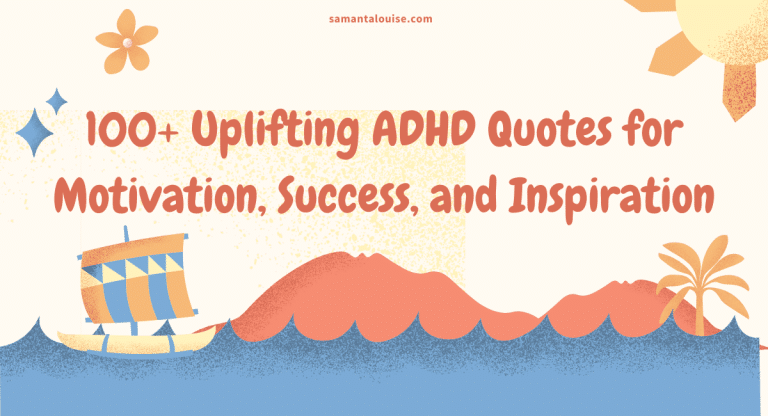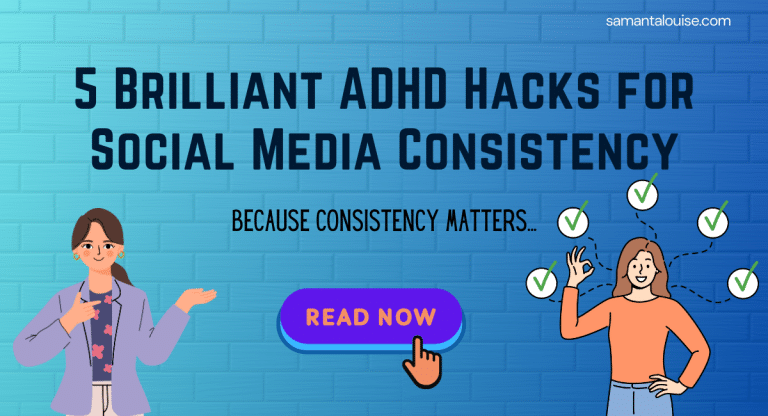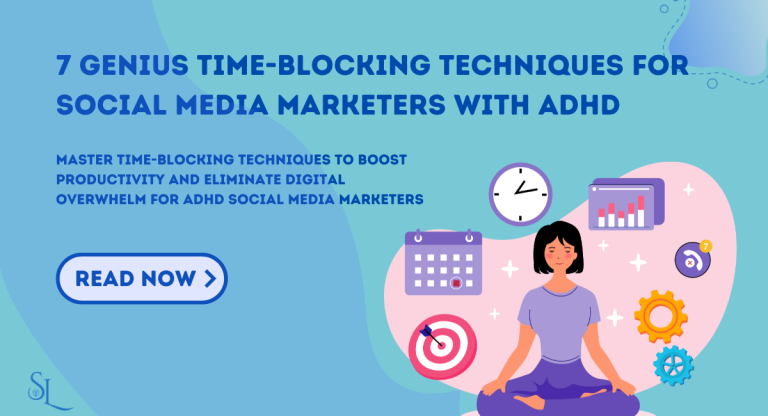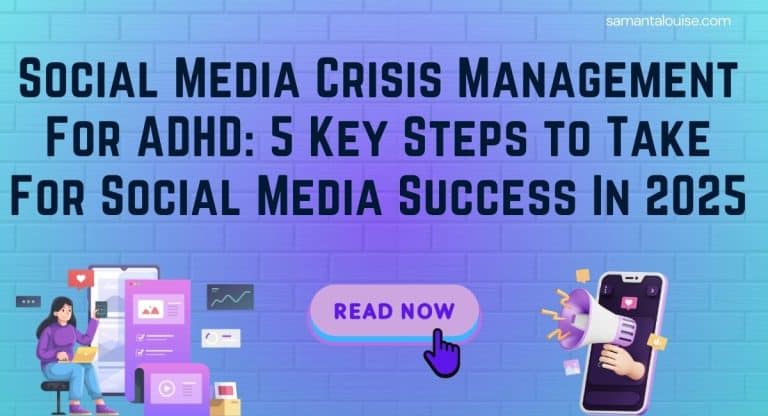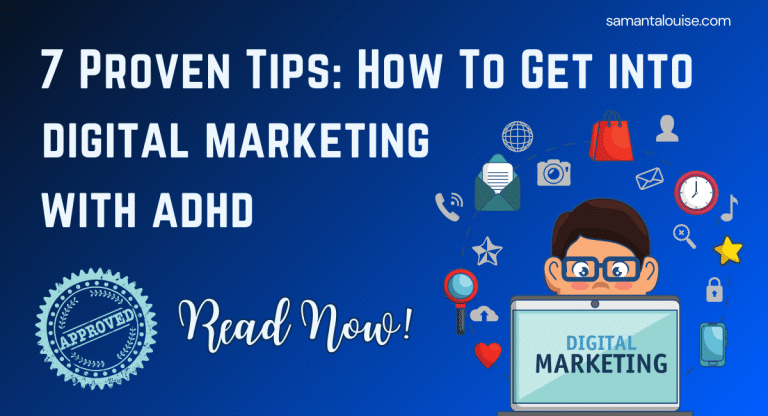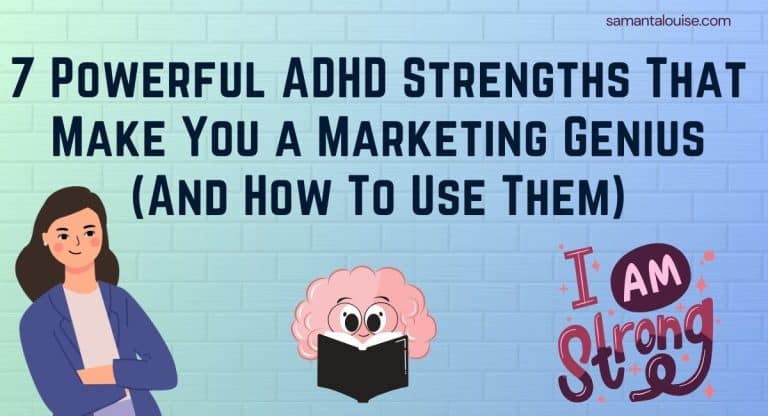Overcome ADHD Burnout: 7 Tips for Social Media Success
Imagine staring at your content calendar, dozens of half-finished drafts scattered across your desktop, and that familiar weight of overwhelm starts taking over. Your usually creative ADHD brain is now running dry on ideas and can’t focus on anything. This goes on for hours, days, weeks… If this ever happened to you, you’re likely familiar with the dreadful experience of ADHD burnout.
As a digital marketer with ADHD, I’ve been there more times than I would like to admit. I know that horrible soul-draining feeling of finding basically anything too difficult to complete, even if you have done it a thousand times before. Add today’s non-stop social media marketing experience to the mix, and overcoming the burnout cycle might be even harder, especially if you are not following ADHD-friendly methods and strategies.
Research has shown that individuals with ADHD often experience higher levels of stress and emotional exhaustion in demanding work environments, particularly in roles requiring constant attention switching and deadline management – exactly what digital marketing demands of us every day.
After years of multiple burnout cycles and using almost every tip, trick and strategy under the sun, I finally discovered that the key isn’t fighting against our unique brain wiring – it’s working with it. In this guide, I’ll share the exact strategies I use to prevent and recover from ADHD burnout while maintaining a successful digital marketing career.
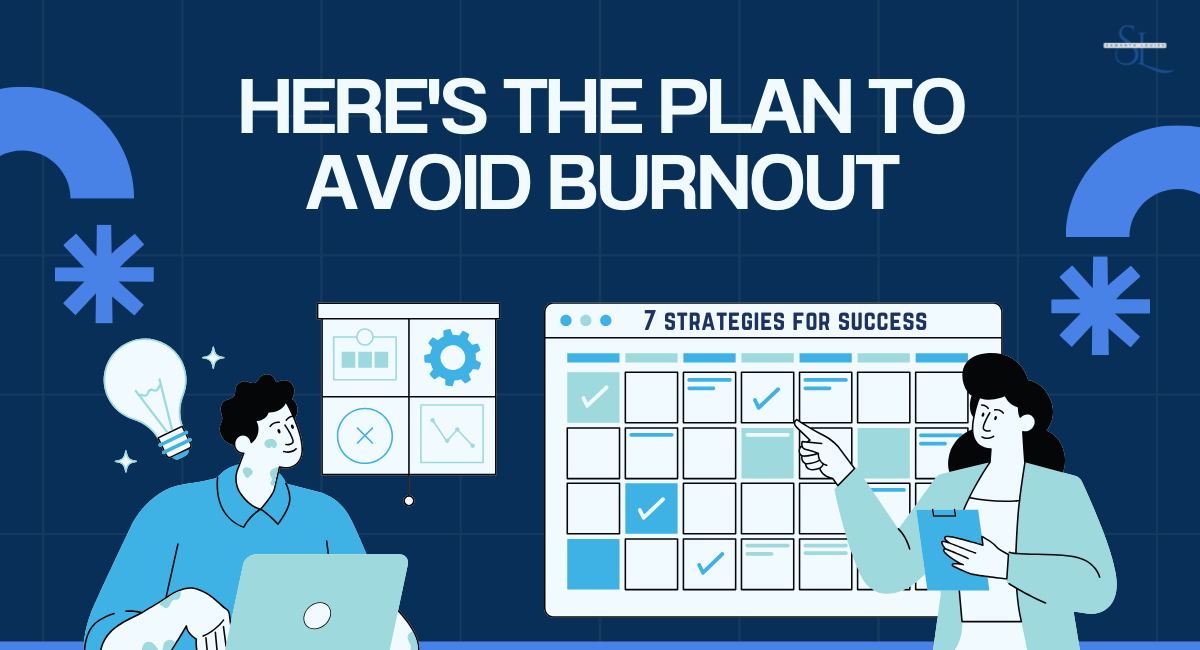
Understanding ADHD Burnout in the Digital Space
Doing social media marketing when you have ADHD can be challenging and the most seasoned and passionate content creator can experience ADHD burnout symptoms at the peak of their careers. So, we can say that the digital space can be both a blessing and a curse, especially if you do not have an ADHD-friendly digital marketing workflow in place.
It’s not just about feeling tired – it’s a deep overwhelming exhaustion that creeps up on you. Digital overwhelm becomes like a parasite that slowly drains you over time, especially when you are managing multiple platforms and trying to keep up with never-ending notifications. Before we jump into the 7 tips that reversed this cycle of doom for me, you should understand what ADHD burnout is and how to recognise it.
What Is ADHD Burnout?
ADHD burnout is a state of physical, mental, and emotional exhaustion that occurs when someone with ADHD has pushed themselves beyond their energy limits for too long. Unlike regular tiredness, ADHD burnout can make even basic tasks feel impossible to complete.
To explain this better, think of your brain as an older phone that drains faster than others and needs more frequent charging. When you have ADHD, your brain uses up more energy to do everyday tasks than someone without ADHD. Burnout happens when you completely drain that battery by pushing yourself too hard or too long. Your battery hits 0% and you can’t do anything anymore.
Anyone might experience burnout in their life if they push too hard but what makes ADHD burnout different? ADHD burnout drains both your energy and your brain’s ability to function, making even basic tasks feel overwhelming. It is like running a marathon with weights on your legs.
Every impact of burnout becomes more intense as the executive dysfunction takes over and makes you feel frustrated at almost anything you do. Therefore, understanding these challenges is the first step to managing them. Mental health social media awareness is crucial, especially when you’re dealing with ADHD.
It’s not just about pushing through – it’s about recognizing when your brain needs a break and knowing how to provide that relief without letting your content strategy fall apart. Experiencing burnout doesn’t mean you’re failing – it means you’re human, and your brain is telling you something important.
Recognizing the ADHD Burnout Cycle in Social Media Work
After experiencing multiple burnout cycles throughout my adolescence and early career, I have learned to recognise the mental and physical symptoms of ADHD burnout. If you catch the symptoms earlier on, you can prepare and take the necessary actions to deal with it. Here are some warning signs I have experienced when dealing with social media stress:
- Finding myself stuck in endless scrolling loops when I should be creating content
- Experiencing intense platform fatigue where even opening my social media apps feels exhausting
- Noticing increased task-switching fatigue between different platforms or projects
- Feeling a rising sense of panic when notifications pop up
I remember one particularly challenging period where my own content creation workflow completely fell apart. I now realise that the first sign was the feeling of dread I felt every time I needed to switch between tasks. This is what I now recognize as classic ADHD executive dysfunction manifesting in digital work.
Common triggers to look out for
Not all triggers are the same for everyone but I have noticed that they tend to manifest in these ways when doing social media marketing:
- Algorithm changes that disrupt your established routines
- Pressure to maintain consistent engagement while managing social media overwhelm
- The constant need for attention regulation across multiple platforms
- Client or follower demands that conflict with your natural work rhythm
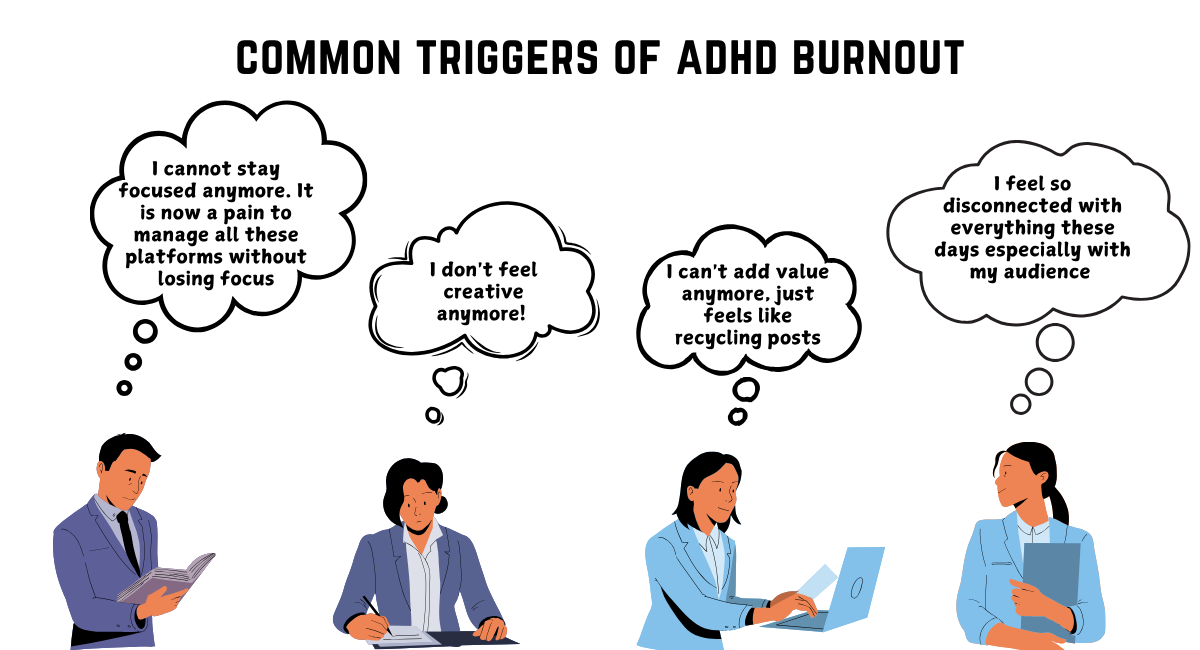
The impact on your work can be subtle at first, but it quickly snowballs. I’ve noticed that creative burnout often shows up as:
- Recycling old content without adding value
- Struggling to maintain your usual creative spark
- Finding it increasingly difficult to focus during content planning sessions
- Feeling disconnected from your audience
What’s particularly tricky about social media management with ADHD is how the symptoms can masquerade as simple productivity issues. But here’s what I’ve learned: when you start seeing your content planning strategies fall apart, it’s rarely just about time management – it’s often your brain telling you it needs a reset.
When ADHD burnout starts creeping in, your content quality usually takes the first hit. I’ve seen brilliant creators reduce their output to the bare minimum posts, losing that special touch that made their content unique. This isn’t just about having an “off day” – it’s about recognizing when your brain needs serious attention to digital wellness.
In my experience, the sooner you recognize and respond to these warning signs, the easier it is to prevent a full-blown burnout episode and maintain your creative edge.
7 Effective Tips To Break the Burnout Cycle
After years of working as a digital marketer with ADHD and experiencing multiple burnout cycles, I have found the best strategies that work for our unique ADHD brain to prevent burnout outbreaks and manage your digital space effectively. TI want to highlight that these tips are not only to overcome burnout but to prevent one as well. If you take action and
1. Implement the “Content Batching” Method
Content batching is an incredible method to reduce task-switching in your social media marketing work. It is grouping similar tasks and working on them during a specific timeframe. In this way, you can make the most out of your natural hyperfocus tendencies. Here’s how it works: dedicate specific days to creating similar types of content. For instance, Monday might be your writing day, where you draft all your captions and blog posts for the week. Tuesday could be video editing day, and so on.
The key is to work with your brain’s natural rhythms. Use templates to reduce decision fatigue, and always build in buffer time for those inevitable moments when you feel inspired or you struggle to focus. For example, if you set up 2 hours to create Instagram reels, schedule 30 mins right after it and do not assign any task to yourself during that time. That’s a buffer zone.
I usually do content batching for creative social media tasks such as creating and editing content. I also shoot my videos at one go because I am already dressed up – just need to switch outfits! This takes away the pressure of task-switching because I know what to expect from the session. I usually have SOPs (Standing Operating Procedures) or checklists to follow. In this way, I do not have to sit down and think about what to do next, which often leads to ADHD task paralysis.
You can check out my guide on the best ways to do social media content batching if you want to be more efficient at this.
2. Create a Task Management System
If you are sitting in front of your desk wondering what to do next each time you start work, you are in for failure. Let alone the notification beast always seeking your attention, an overwhelming list of tasks or to-dos can lead to burnout. Dealing with ADHD burnout requires more than a social media detox, you need to adopt a preventive approach that works with your ADHD brain.
Through a task management system, you can easily track all your tasks and work on them in an organised manner. The best way to implement this is through a calendar or a Notion task management template. I use Notion because I can use Notion Calendar in conjunction and sync all my tasks to the calendar. This helps in avoiding ADHD job burnout. Let me break down the process of how you can implement this:
- Create a calendar – it can be a Notion or Google calendar (I highly recommend Notion as it can be synced with Google Calendar)
- List all your recurring tasks for the week – for example, editing reels or posting on Pinterest
- Download a task management template on Notion
- Link the template with your Notion calendar and start tracking your tasks for the week
- Update it every day for non-recurring tasks
This approach helps in managing your daily tasks and building effective and efficient routines. It takes away the feeling of not knowing what to do.
3. Use the Pomodoro Technique for Social Media Tasks
The Pomodoro Technique is a time management method that works wonders for ADHD brains, especially when adapted for social media work. Here’s how I modify it for my clients: Set a timer for 25-minute focused work periods (called a Pomodoro) . During this time, commit to working on a single task without switching. When the timer rings, take a 5-minute active break – stretch, walk around, or hydrate. This physical movement is crucial for resetting our often restless ADHD minds.
After completing four cycles, reward yourself with a longer break. The key is to track your most productive time windows and schedule your most challenging tasks during these periods. Many find that their ability to focus fluctuates throughout the day, so this technique helps capitalize on natural energy peaks.
I use Focus To-Do to track all my Pomodoros. It is the best mobile Pomodoro timer that lets you track your focus time with helpful analytics, create checklists for your tasks, put white background noise for enhanced focus, block apps in strict mode, schedule tasks and create projects.
The best way to implement this method is to use time boxing for your tasks. For example, assign 3 hours on Tuesdays to creating Pins on Canva. Then use the Pomodoro technique to break down the 3 hours of work into focus blocks of 30 minutes with 10-minute breaks in between. At the end of 4 Pomodoros or the whole time box, you should reward yourself with something you like to increase motivation.
The goal is not perfection – it’s progress. Even if you only complete one or two cycles, that’s still focused work accomplished. There will be good and bad days and you must be ready to work with that and go on.
4. Design a Structured Content Calendar
If you are managing multiple social media accounts, it can be overwhelming over time especially if you switch from one platform to another. From experience, I know that it can be demotivating if you miss posting on one platform and completely give up on other platforms too, which is why having a structured content calendar helps.
Start by color-coding different content types – this visual organization can be a lifesaver when you’re feeling overwhelmed. Include buffer days for unexpected challenges or creative blocks; this flexibility is crucial for managing ADHD-related inconsistencies in productivity. Plan content themes in advance, but leave room for spontaneity.
I usually use AI to brainstorm my themes and plan one month in advance then fill in specifics weekly. This approach provides direction while allowing for those brilliant last-minute ideas we often get. Build in time for engagement and community management – these tasks often get overlooked but are crucial for social media success.
I use a Notion content calendar for all my social media channels and use Later to schedule the content. In this way, I do not have to worry that the created content won’t be published. Later is great because it provides a lot of features to ensure consistency. It comes with AI-powered features that can save you a lot of time.
You can check out my article on the 21 best social media tools that have helped me streamline my social media marketing workflow and made my posting schedule more consistent. These ADHD-friendly tools are must-haves for social media marketers with ADHD.
5. Establish Clear Work Boundaries
Setting boundaries is essential for ADHD professionals in the always-on world of social media. Start by defining specific working hours and stick to them as much as possible. Create a dedicated workspace, even if it’s just a corner of a room, to signal to your brain that it’s time to focus.
You should not mix working time with leisure time – it will end badly. Use time-blocking to designate periods for different tasks – content creation, engagement, analytics review, etc. This structure helps combat the tendency to flit between tasks. My favourite time-blocking techniques involve time boxing, the Pomodoro technique, themed days and content batching.
You should not feel like you should be online all the time. Set specific times for work. For example, 1 hour daily for social media engagement. Crucially, communicate your availability clearly to clients and followers. Set expectations about response times and working hours. It’s okay to not be available 24/7!
You can use automation tools to respond to your audience. A good example is Manychat. You can use pinned posts to inform your audience about crucial information. Boundaries are not just about saying no to others – they are about saying yes to your own well-being and productivity.
You should not neglect your work-life balance in the quest for social media success. You should be disciplined and respect your work environment. Do not work in the bedroom! Consistent boundaries lead to more sustainable and enjoyable social media work.
6. Utilize ADHD-Friendly Automation Tools
Automation is a powerful ally for ADHD social media professionals. Why do things that you can automate? So, devote some time to finding out which tasks in your social media marketing workflow can be automated. Aim to automate repetitive tasks, these tasks are the most draining ones because they are boring.
Scheduling posts across multiple social media platforms is an excellent example of automation. This allows you to capitalize on periods of high creativity without feeling pressured to post in real time. You can also use templates if you are not able to use complex automation tools – this reduces decision fatigue and ensures consistency in your messaging. Set up automated engagement tracking to simplify your analytics process.
One often-overlooked automation tip: create a library of auto-responses for common messages or comments. This saves time and mental energy, allowing you to engage more meaningfully when necessary. My favourite automation tool is Make. It is a full-fledge automation tool that allows you to connect multiple platforms including AI tools like Chatgpt. If you are willing to put some initial work into learning, you can fully automate some processes in your social media marketing workflow.
The goal of automation isn’t to remove the human touch from your social media presence, but to free up your time and mental resources for more creative and strategic tasks. Experiment with different tools to find what works best for your specific needs and workflow. You can check my article on social media automation tools and how to use them to automate some of your processes.
7. Practice Digital Detox Periods
Regular digital detoxes are crucial for maintaining mental health and creativity in social media work, especially for ADHD brains. Schedule weekly offline periods – even a few hours can make a significant difference. You do not have to wait until you are drowning in burnout to implement this. Sometimes, staying away from social media for some time can be a refresher.
Social media detox time can be used for activities that recharge you, whether it’s outdoor adventures, reading, or spending time with loved ones. Many people tend to get confused with the term social media detox. They think it means cutting off entirely from social media and therefore resort to this only when they are already experiencing burnout.
Social media detoxes can be as simple as creating tech-free morning and evening routines to book your day. This helps signal to your brain when it’s time to wind down or gear up for work. You can also plan regular outdoor activities – nature has a remarkable ability to reset our often overstimulated ADHD minds.
It does not have to be a hibernation phase in your life. Viewing it as this only makes it difficult to implement. taking time away from social media doesn’t mean you’re neglecting your work. Instead, you’re investing in your long-term productivity and creativity. These detox periods often lead to fresh ideas and renewed enthusiasm for your social media tasks.
Final Tips
Remember, these strategies aren’t one-size-fits-all. I always tell my clients to experiment and adapt these methods to their unique needs. The key is finding what works for your specific ADHD traits while maintaining a productive content creation workflow.
Pro Tip: Start implementing these strategies gradually. Trying to change everything at once can trigger overwhelm. Pick one method, master it, and then add another. This approach has helped many of my clients build sustainable social media practices while managing their ADHD effectively.
How to Prevent ADHD Burnout in the Future
As I said, you should not wait for the burnout to come by before deciding to take action. Instead, you should take preventive measures to avoid one. Over the years, I’ve identified key strategies for maintaining effective ADHD task management in social media work. Let’s dive into how we can build resilience and prevent future burnout cycles.
Methods to Prevent Burnout and ADHD Challenges
1. Create sustainable daily practices
You need to develop workflow optimisation techniques that can withstand the unique challenges of ADHD. I’ve found that successful creators implement what I call the energy banking system. This means actively tracking your mental energy management, just like monitoring a bank account. When you notice your energy getting low, it’s time to strategically adjust your workload.
2. Build resilience in your digital work
Create flexible systems that bend rather than break under pressure. This includes developing multiple content creation workflow methods that you can switch between based on your energy levels. For instance, when written content feels overwhelming, having a video format backup plan can keep you productive without burning out.
3. Create support systems
The most successful ADHD social media professionals don’t go it alone. Building a robust support system is crucial for preventing social media overwhelm. This includes:
- Finding an ADHD-informed mentor or coach
- Joining communities of other neurodivergent creators
- Building relationships with accountability partners
- Creating a network of backup support for low-energy periods
- Establishing connections with other professionals who understand ADHD challenges
The key is to view burnout prevention as an ongoing process rather than a one-time fix. By implementing these strategies consistently and adjusting them as needed, you can create a sustainable social media career that works with your ADHD, not against it.
When to Seek Professional Help?
Recognizing when you need help is a crucial part of successful ADHD task management. Let’s explore the signs that indicate it’s time to seek additional support and what resources are available.
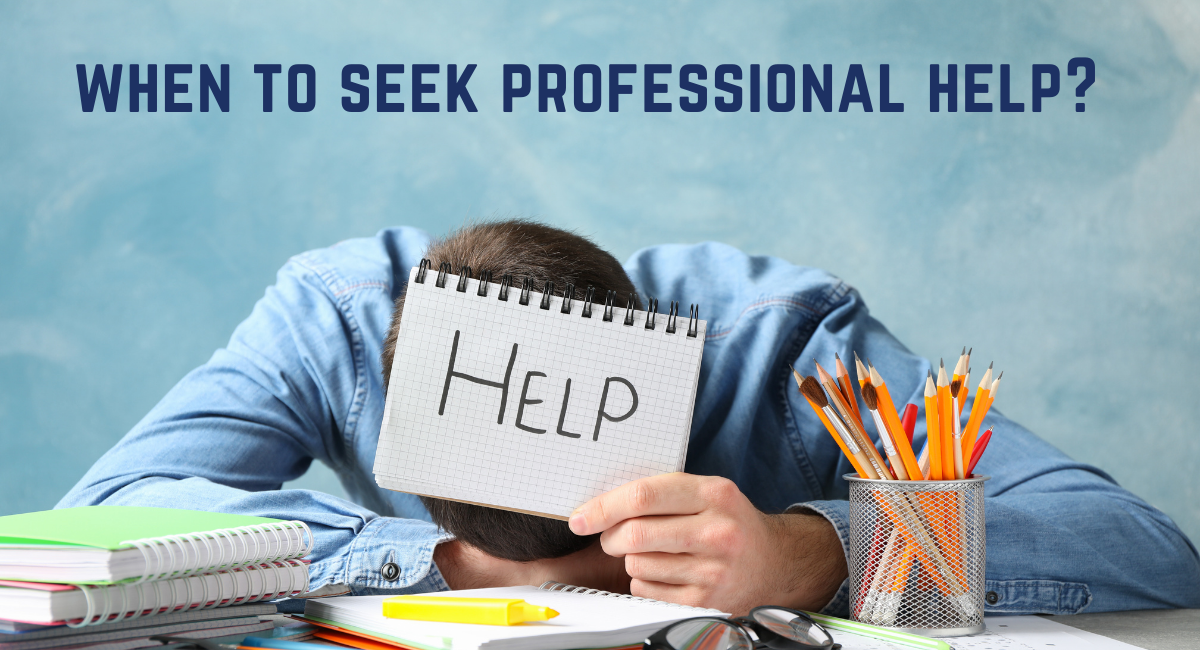
Signs You Need Additional Help
When your existing workflow optimization strategies aren’t working, watch for these indicators:
- Consistently missing deadlines despite your best efforts
- Experiencing frequent overwhelm with basic tasks
- Finding your mental energy management techniques aren’t effective
- Struggling to maintain basic work routines
- Feeling isolated or stuck in negative patterns
- Seeing a significant decline in work quality
Use available resources for social media professionals with ADHD
There are numerous support options designed to help manage social media overwhelm:
- ADHD coaches specializing in digital careers
- Online communities focused on content creation workflow
- Professional organizers with ADHD expertise
- Mental health professionals who understand creative industries
- Productivity apps and tools designed for neurodivergent minds
- Educational resources about ADHD in the workplace
Seeking support isn’t a sign of weakness – it’s a strategic move toward sustainable success in your social media career. Professional help can provide the structure and guidance needed to thrive with ADHD in the digital space.

